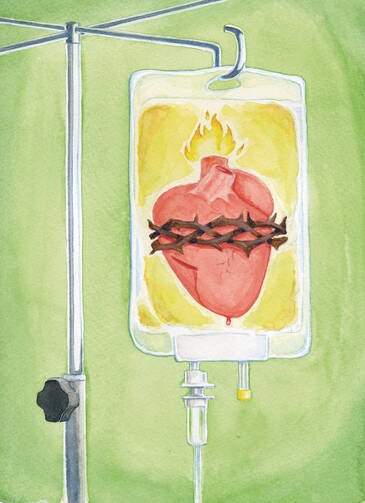My preparation to become a father was easier than I expected. Apart from attending doctor’s appointments, assembling the crib and a few trips to buy frozen yogurt, my life remained relatively unchanged. At one point, my wife, Molly, gave me a book on fatherhood that she had received from a friend. This book bore the scars of a serious father-to-be: worn, dog-eared pages, yellow highlighting and a rainbow of Post-it notes. I thanked her for the book and set it aside on the nightstand, where it stayed. I was excited, for sure, but things just seemed far away, and I was caught up in the day-to-day duties of work and life.
I am not sure how prepared I could have been when our son Sean arrived six weeks early. Sean’s birth had come so unexpectedly that it almost did not seem real. But there he was: a tiny little gift from God, a preemie whose heart and respiration rates would require extra monitoring. We dug in for an extended hospital stay, holding on to hope that we could bring Sean home in a week or two.
It seems funny to say that a person is acting strange when you have only known him for 10 days; but one Sunday, Sean was not acting like himself. He was sleepy and was not eating. At 10 p.m., we got a knock on the door. The pediatrician had been monitoring Sean’s heart and believed that something was seriously wrong. She had already called Boston Children’s Hospital, and they were sending a special cardiac ambulance. Molly and I looked at each other with panicked faces, again wondering if this was actually happening.
It was. Tests confirmed that our son had developed a condition called a coarctation of the aorta, a heart defect that constricts his blood flow and could lead to heart failure. He would need surgery, and the next available slot was the following day. We absorbed the news and took turns holding vigil next to Sean. Molly had the first shift. I went to the family waiting area, took two bites of a muffin and proceeded to stare blankly at it for some period of time. I became aware of a couple sitting near me; they were parents as well, and their little boy was across the hall from Sean. I could not muster a smile, never mind the usual pleasantries.
I did not know it at the time, but these parents, along with the other families in the cardiac intensive care unit, would teach me more about parenting than any book possibly could. It was here I found the patience and care of parents under incredible stress. It was here that I learned firsthand about the gift of new life and just how fragile it can be. It was here that I witnessed a kind of love that was altogether new to me.
Later that day, a stuffed animal arrived courtesy of the parents I met in the waiting area, along with a card that welcomed us into the world of “heart moms and dads.” I became a silent admirer of this couple, whose child had undergone multiple surgeries. They were just across the hall, and though I tried to give them privacy, my gaze kept wondering in their direction, peeking between the curtains to see how experienced parents handle this sort of stress. I could see they had it together. They knew the purpose of each IV line and tube; they asked the doctors spot-on questions.
In a short time, I too became well versed in cardiac matters, thanks to the patient explanations of Sean’s doctors. But I also found myself thinking of Jesus’ heart, especially the rather anatomical depiction that I have seen in so many stained-glass church windows. Growing up, I was very familiar with the image of the Sacred Heart, but I had no real understanding of the theology behind it.
Last year, a colleague recommended Henri Nouwen’s Heart Speaks to Heart, which helped me gain a new understanding of this devotion. Nouwen describes an invitation to enter the wounded heart of Jesus. He enters into a dialogue with Jesus, who tells him, “Know that I have come to give you a new heart and spirit, yes, even a new body in which the struggles of your life can be seen as signs of beauty and hope.”
Such signs of beauty and hope were everywhere in the children’s heart intensive care unit. It was next door, where I saw a rather tough-looking father asleep, holding the hand of his son, a young man with Down syndrome. There was a young girl of maybe 4 or 5, who came by our room with freshly painted nails, a nurse with an IV line in tow. She, like many other children in the ward, just wanted to see the tiny baby down the hall. She gave a few smiles and ooh’s to Sean as she gingerly tested her heart by walking around the floor.
Sean’s surgery was, thank God, a success. Unfortunately, his “one and done” operation and excellent prognosis were not the norm. Children come to Boston Children’s from all over the country for a second or third chance at repairing their hearts. We had the good fortune of living 30 minutes away from a world-class institution. After Sean’s surgery, as we prepared to transfer out of the intensive care unit, a feeling of guilt crept into my sense of relief. Our son was doing better, but so many children were still struggling. In my final conversation with the couple across the hall, they could sense my mixed feelings. Yet they were so positive and happy for us. Rejoice in your son, they said, and pray for ours.
In a place in which each child had a wounded heart, we were overwhelmed by the love and generosity of strangers, of “heart moms and dads” who modeled the most important lessons to two new parents.








